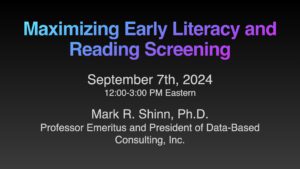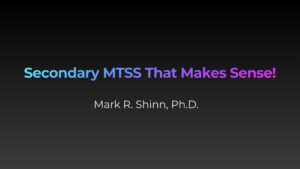Mark R. Shinn, Ph.D. And His Current Webinar Offerings

Maximizing Reading (and Early Literacy) Screening Success
With demands for dyslexia screening exploding across the Country, screening within a Benchmark model has become increasingly complicated and time expensive. Teams and TEACHERS are overwhelmed with data that often is not used or used inappropriately. It's TIME to re-think how we screen, learning from research and practice to maximize the use of data.
The webinar identifies:
Why LESS IS MORE!
Why R-CBM, a short, readily available oral reading test (aka Oral Reading Fluency, ORF) is the most essential test in MTSS, including Screening
Differences between Screening and Diagnostic (instructional planning) tests that should be optional, significantly reducing time
What grades should Benchmarking switch to 1x per year Universal Screening and when Universal Screening should switch to Individual Student Screening so testing times can reduced or eliminated
Why Risk cut scores (e.g., High Risk) are important data yet are often not useful for Screening, but for Program Evaluation
How norm-based cut scores are most valuable when your school may not be like middle America
Rates of Improvement (ROI) and cautions for their use
How to align your cut scores to resources so schools can allocate their MTSS resources to unburden classroom Tier 1 instruction
RESCHEDULING
Individual Purchase- $49
Individual Purchase- $49
We are making Group Discounts more explicit by offering Coupons.
purchaseorder2024 for persons/groups paying by Purchase Orders and Invoices
smallteam which is 3-10 attendees and provides a 30% discount
largegroup which is groups larger than 10 which offers a 40% discount
FOR OTHER QUESTIONS contact Dr. Mark R. Shinn at 847.275.7200 or [email protected]

Secondary MTSS That Makes Sense
MTSS/RTI as typically implemented often doesn't make sense to secondary teachers. The ideas of screening, Tiers, and progress monitoring are very unlike what secondary content teachers do every day.
This webinar presents a practical, compelling model of how some middle and high school students still require Treatment because they still lack the basic skills they need for content area success while other students struggle in content area classes and require Support.
The basis for decision making is the Big Idea of Minimum Basic Skills Proficiency (MBSP), a cut score to differentiate Treatment and Support. The webinar provides screening practices and MBSP cut scores aligned to MBSP and features of Secondary MTSS implementation that are unique and enable schools Secondary schools are especially adept at providing Treatment if a commitment is made to an MTSS model because of their scheduling expertise and the webinar will identify many of these strategies that have been shown to raise achievement, not just for struggling students, but for all students. I will illustrate how MTSS, when implemented with fidelity, can make the difficult job of teaching a little bit easier.
RESCHEDULED
Individual Purchase- $49
We are making Group Discounts more explicit by offering Coupons.
purchaseorder2024 for persons/groups paying by Purchase Orders and Invoices
smallteam which is 3-10 attendees and provides a 30% discount
largegroup which is groups larger than 10 which offers a 40% discount
FOR OTHER QUESTIONS contact Dr. Mark R. Shinn at 847.275.7200 or [email protected]

RtI As SLD Eligibility: Foundational Big Ideas and Implementation Plans
To many educators' surprise, "RtI-Like" eligibility practices have been implemented in America's schools since the early 1980s! More than 20 years later, in 2004 after accumulated research and further complaints about the ability-achievement discrepancy model of SLD identification, IDEA legally permitted RtI at the federal level. Since then, more than 20 states permit RtI and some require it. Still, many schools struggle with RTI implementation. Some choose not to try because of fears of "difficulty."
In 2024, I see schools backsliding or giving up in Rti as SLD "because it is too hard" to do. From my own observations, I would agree! I see a lack of procedural clarity, too much PROCESS and time, paperwork, and a hesitancy to implement RTI unless "things are perfect." I hear "we can't implement RtI until we get a strong Tier 1 core Program" or "we don't have good progress monitoring data!" Even more frustrating is the fear of getting "caught out of compliance."
These are all solvable problems." This webinar identifies "big ideas" that key parties must understand for successful implementation of (any) SLD implementation and in particular, what is "new" in RtI, the Inclusionary Factors. How to operationalize ALL components in RtI, especially the Inclusionary Factors, will be addressed, especially in a transition to an RTI model. In addition, efforts to waylay worries of litigation will be presented, with careful attention to more likely weaknessess in other components of SLD eligibility in current practices, including RtI.
RESCHEDULED
Individual Purchase- $49
We are making Group Discounts more explicit by offering Coupons.
purchaseorder2024 for persons/groups paying by Purchase Orders and Invoices
smallteam which is 3-10 attendees and provides a 30% discount
largegroup which is groups larger than 10 which offers a 40% discount
FOR OTHER QUESTIONS contact Dr. Mark R. Shinn at 847.275.7200 or [email protected]
